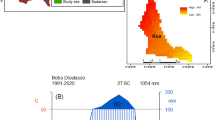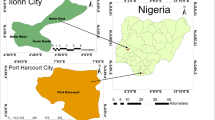Abstract
Carbon sequestration is one of the most prominent measures for mitigating the impact of climate change. Urban forests depend on the composition of vegetation, species structure, human influence, and management activities as an effective means of balancing carbon in the city areas. The study considered 41 plots, covering an area of 1.025 ha and assessed the role of the urban forest in carbon offsetting. Based on the diameter at breast height (DBH) and height of trees information, the allometric equation is deployed to determine the biomass of the trees. The forest had species richness 39, Shannon–Wiener diversity index (H’) 2.4996, Pielou’s evenness index 0.6872, and the carbon 720.26tC/ha. The normality of the data was determined using the Shapiro–Wilk test. The relationship of species richness and diversity with carbon stock was determined using Spearman’s rank correlation. Neolitsea cuipala (119.06tC/ha) had more carbon storage potential followed by Holarrhena pubescens (73.57tC/ha) ranging from (0.3–119.06) tC/ha. Long-term monitoring of these tree communities for their conservation management is suggested.
Access this chapter
Tax calculation will be finalised at checkout
Purchases are for personal use only
Similar content being viewed by others
References
Agrawal S (1992) Fundamental of ecology. Ashish publishing House, New Delhi
Baur JW, Ries P, Rosenberger RS (2020) A relationship between emotional connection to nature and attitudes about urban forest management. Urban Ecosystems 23:187–197
Bhattarai BP, Kindlmann P (2012) Impact of livestock grazing on the vegetation and wild ungulates in the Barandabhar Corridor Forest, Nepal. Himalayan biodiversity in the changing world. Springer
Bhusal DR, Ghimire KC, Dulal S, Baniya P, Thakuri S (2019) Spatial relation of bumblebees (Hymenoptera-Apidae) with host-plant and their conservation issues: an outlook from urban ecosystem of Kathmandu Valley, Nepal. Eur J Ecol 5:1–7
Bluffstone R, Dannenberg A, Martinsson P, Jha P, Bista R (2020) Cooperative behavior and common pool resources: Experimental evidence from community forest user groups in Nepal. World Dev 129:104889
Bradshaw CJ, Warkentin IG (2015) Global estimates of boreal forest carbon stocks and flux. Global Planet Change 128:24–30
Chave JR, Andalo C, Brown S, Cairns MA, Chambers JQ, Eamus D, Fölster H, Fromard F, Higuchi N, Kira T (2005) Tree allometry and improved estimation of carbon stocks and balance in tropical forests. Oecologia 145:87–99
Dangal SP, Das AK, Paudel SK (2017) Effectiveness of management interventions on forest carbon stock in planted forests in Nepal. J Environ Manage 196:511–517
Das A, Yadav G, Layek J, Lal R, Meena R, Babu S, Ghosh P (2020) Carbon management in diverse land-use systems of Eastern Himalayan Subtropics. Carbon management in tropical and sub-tropical terrestrial systems. Springer
Ebenberger M, Arnberger A (2019) Exploring visual preferences for structural attributes of urban forest stands for restoration and heat relief. Urban Forest Urban Green 41:272–282
Erdős L, Krstonošić D, Kiss PJ, Bátori Z, Tölgyesi C, Škvorc Ž (2019) Plant composition and diversity at edges in a semi-natural forest–grassland mosaic. Plant Ecol 220:279–292
Escobedo F, Varela S, Zhao M, Wagner JE, Zipperer W (2010) Analyzing the efficacy of subtropical urban forests in offsetting carbon emissions from cities. Environ Sci Policy 13:362–372
Feng H, Nursey-Bray M (2020) Adaptation by herders on the Qinghai-Tibetan Plateau in response to climate change and policy reforms: the implications for carbon sequestration and livelihoods. Carbon management for promoting local livelihood in the Hindu Kush Himalayan (HKH) Region. Springer
Forrester D, Bauhus J (2016) A review of processes behind diversity—productivity relationships in forests. Curr For Rep 2:45–61
Hornsey MJ, Fielding KS (2020) Understanding (and reducing) inaction on climate change. Soc Issues Policy Rev
Hulme M (2020) Is it too late (to stop dangerous climate change)? An editorial. Wiley Interdiscipl Rev: Clim Change 11:e619
Jana SK, Roy J (2020) Biodiversity and impacts of climate change in home gardens: evidence from a study in West Bengal, India. Current State and Future Impacts of Climate Change on Biodiversity, IGI Global
Jim CY, Chen WY (2009) Ecosystem services and valuation of urban forests in China. Cities 26:187–194
Kemeuze V, Mapongmetsem P, Sonwa D, Fongnzossie E, Nkongmeneck B (2015) Plant diversity and carbon stock in sacred groves of semi-arid areas of Cameroon: case study of Mandara mountains. Int J Environ 4:308–318
Khadka SR, Schmidt-Vogt D (2008) Integrating biodiversity conservation and addressing economic needs: an experience with Nepal’s community forestry. Local Environ 13:1–13
Khanal N, Uddin K, Matin MA, Tenneson K (2019) Automatic detection of spatiotemporal urban expansion patterns by fusing OSM and landsat data in Kathmandu. Remote Sens 11:2296
Khumbongmayum AD, Khan M, Tripathi R (2006) Biodiversity conservation in sacred groves of Manipur, northeast India: population structure and regeneration status of woody species. Human exploitation and biodiversity conservation. Springer, New York
Krebs CJ (1972) Ecology the experimental analysis of distribution and abundance
Laakkonen A, Hujala T, Pykäläinen J (2019) Integrating intangible resources enables creating new types of forest services-developing forest leasing value network in Finland. Forest Policy Econ 99:157–168
Liu C, Li X (2012) Carbon storage and sequestration by urban forests in Shenyang, China. Urban for urban green. Elsevier GmbH, New York
Liu L, Huang G, Baetz B, Guan Y, Zhang K (2020) Multi-dimensional hypothetical fuzzy risk simulation model for greenhouse gas mitigation policy development. Appl Energy 261:114348
Macdicken KG (1997) A guide to monitoring carbon storage in forestry and agro-forestry projects. Winrock National Institute for Agricultural Development, Arlington, USA
Markum M, Soesilaningsih EA, Suprayogo D, Hairiah K (2014) Plant species diversity in relation to carbon stocks at Jangkok Watershed, Lombok Island. AGRIVITA, J Agric Sci 35:207–217
Mattsson E, Ostwald M, Nissanka S, Pushpakumara D (2015) Quantification of carbon stock and tree diversity of homegardens in a dry zone area of Moneragala district, Sri Lanka. Agrofor Syst 89:435–445
Meena RS, Kumar S, Yadav GS (2020) Soil carbon sequestration in crop production. Springer, Nutrient dynamics for sustainable crop production
Narayana J, Nanda A, Savinaya MS (2020) Carbon sequestration potential of trees in Kuvempu University Campus Forest Area, Western Ghats, Karnataka. Socio-economic and eco-biological dimensions in resource use and conservation. Springer
Nave LE, Vance ED, Swanston CW, Curtis PS (2010) Harvest impacts on soil carbon storage in temperate forests. For Ecol Manage 259:857–866
Odum EP, Barrett GW (2005) Fundamentals of ecology. 5th edn. Thomson Brooks/Cole, Belmont, CA
Odum HT (1967) Biological circuits and the marine systems of Texas
Pachauri RK, Allen MR, Barros VR, Broome J, Cramer W, Christ R, Church JA, Clarke L, Dahe Q, Dasgupta P (2014) Climate change 2014: synthesis report. Contribution of Working Groups I, II and III to the fifth assessment report of the Intergovernmental Panel on Climate Change, Ipcc
Page NV, Qureshi Q, Rawat GS, Kushalappa CG (2010) Plant diversity in sacred forest fragments of Western Ghats: A comparative study of four life forms. Plant Ecol 206:237–250
Petchey OL, Gaston KJ (2006) Functional diversity: back to basics and looking forward. Ecol Lett 9:741–758
Ren Y, Wei X, Wei X, Pan J, Xie P, Song X, Peng D, Zhao J (2011) Relationship between vegetation carbon storage and urbanization: a case study of Xiamen, China. For Ecol Manage 261:1214–1223
Roy S, Byrne J, Pickering C (2012) A systematic quantitative review of urban tree benefits, costs, and assessment methods across cities in different climatic zones. Urban Forest Urban Green 11:351–363
Saha SK, Nair PR, Nair VD, Kumar BM (2009) Soil carbon stock in relation to plant diversity of homegardens in Kerala, India. Agrofor Syst 76:53–65
Şahin ÜA, Onat B, Ayvaz C (2019) Climate Change and Greenhouse Gases in Turkey. Springer, Recycling and Reuse Approaches for Better Sustainability
Sapkota IP, Tigabu M, Odén PC (2009) Tree Tree diversity and regeneration of community-managed Bhabar Lowland and Hill Sal forests in central region of Nepal 300:57–68
Sayers K, Norconk MA (2008) Himalayan Semnopithecus entellus at Langtang National Park, Nepal: diet, activity patterns, and resources. Int J Primatol 29:509
Sekhri S, Kumar P, Fürst C, Pandey R (2020) Mountain specific multi-hazard risk management framework (MSMRMF): Assessment and mitigation of multi-hazard and climate change risk in the Indian Himalayan Region. Ecol Ind 118:106700
Sharma CM, Tiwari OP, Rana YS, Krishan R, Mishra AK (2018) Elevational behaviour on dominance–diversity, regeneration, biomass and carbon storage in ridge forests of Garhwal Himalaya, India. For Ecol Manage 424:105–120
Shurpali N, Agarwal A, Srivastava V (2019) Introduction to greenhouse gas emissions. Springer, Greenhouse gas emissions
Simpson EH (1949) Measurement of diversity. Nature 163:688–688
Singh A, Unnikrishnan S, Naik N, Duvvuri K (2013) Role of India’s forests in climate change mitigation through the CDM and REDD+. J Environ Plann Manage 56:61–87
Smith B, Wilson JB (1996) A consumer’s guide to evenness indices. Oikos:70–82
Smith W, Grassle JF (1977) Sampling properties of a family of diversity measures. Biometrics:283–292
Sobuj NA, Rahman M (2011) Assessment of plant diversity in Khadimnagar National Park of Bangladesh. Int J Environ Sci 2
Strohbach MW, Haase D (2012) Above-ground carbon storage by urban trees in Leipzig, Germany: Analysis of patterns in a European city. Landsc Urban Plann 104:95–104
Subedi BP, Pandey SS, Pandey A, Rana EB, Bhattarai S, Banskota TR, Charmakar S, Tamrakar R (2010) Forest carbon stock measurement: guidelines for measuring carbon stocks in community-managed forests. Asia Netw Sustain Agric Bioresour Fed Community For Users, Int Cent Integr Mt Dev Katmandú, Nepal 69
Sundarapandian S, Amritha S, Gowsalya L, Kayathri P, Thamizharasi M, Dar J, Srinivas K, Gandhi S (2013) Estimation of biomass and carbon stock of woody plants in different land-uses. Forest Res 3:2
Team RC (2016) R: A language and environment for statistical computing [computer software](version 3.1. 3.). R Foundation for Statistical Computing, Vienna, Austria. https://www.r-project.org (Last viewed June 30, 2016)
ter Braak CJ, Šmilauer P (2015) Topics in constrained and unconstrained ordination. Plant Ecol 216:683–696
Thapa-Magar KB, Shrestha BB (2015) Carbon stock in community managed hill sal (Shorea robusta) forests of central Nepal. J Sustain For 34:483–501
van Kooten GC, Binkley CS, Delcourt G (1995) Effect of carbon taxes and subsidies on optimal forest rotation age and supply of carbon services. Am J Agr Econ 77:365–374
Zhao M, Kong Z-H, Escobedo FJ, Gao J (2010) Impacts of urban forests on offsetting carbon emissions from industrial energy use in Hangzhou, China. J Environ Manage 91:807–813
Acknowledgements
We are thankful to the Gokarna forest committee for helping us by giving permission for research. Thanks go to the forest guide. We are also grateful to Ramesh Sapkota for his immense help. Finally, we thank and acknowledge the anonymous reviewers for their constructive comments.
Author information
Authors and Affiliations
Corresponding author
Editor information
Editors and Affiliations
Appendix
Rights and permissions
Copyright information
© 2021 The Author(s), under exclusive license to Springer Nature Singapore Pte Ltd.
About this chapter
Cite this chapter
Dhakal, S., Mohanty, A., Rijal, K.P. (2021). Assessment of Carbon Sequestration and Tree Diversity in Gokarna Forest, Kathmandu, Nepal. In: Mishra, R.K., Singh, R.B., Dubey, A. (eds) Sustainable Climate Action and Water Management. Advances in Geographical and Environmental Sciences. Springer, Singapore. https://doi.org/10.1007/978-981-15-8237-0_14
Download citation
DOI: https://doi.org/10.1007/978-981-15-8237-0_14
Published:
Publisher Name: Springer, Singapore
Print ISBN: 978-981-15-8236-3
Online ISBN: 978-981-15-8237-0
eBook Packages: Earth and Environmental ScienceEarth and Environmental Science (R0)




